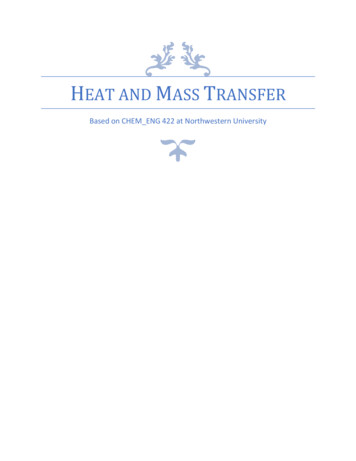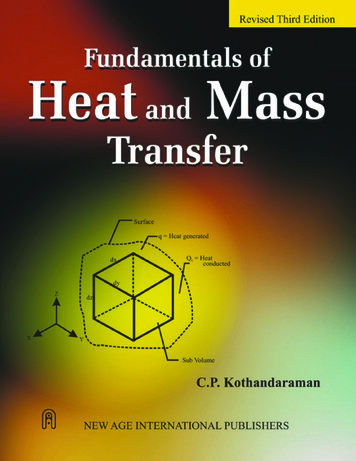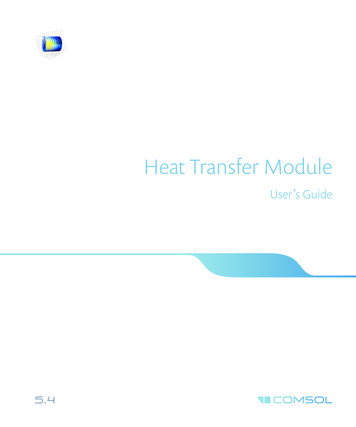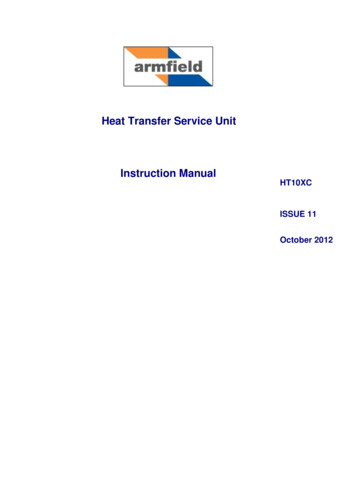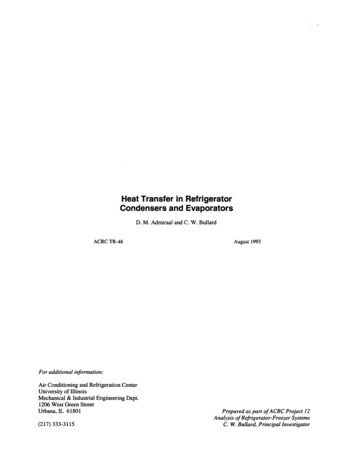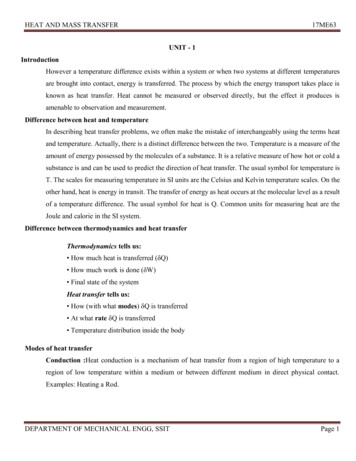
Transcription
HEAT AND MASS TRANSFER17ME63UNIT - 1IntroductionHowever a temperature difference exists within a system or when two systems at different temperaturesare brought into contact, energy is transferred. The process by which the energy transport takes place isknown as heat transfer. Heat cannot be measured or observed directly, but the effect it produces isamenable to observation and measurement.Difference between heat and temperatureIn describing heat transfer problems, we often make the mistake of interchangeably using the terms heatand temperature. Actually, there is a distinct difference between the two. Temperature is a measure of theamount of energy possessed by the molecules of a substance. It is a relative measure of how hot or cold asubstance is and can be used to predict the direction of heat transfer. The usual symbol for temperature isT. The scales for measuring temperature in SI units are the Celsius and Kelvin temperature scales. On theother hand, heat is energy in transit. The transfer of energy as heat occurs at the molecular level as a resultof a temperature difference. The usual symbol for heat is Q. Common units for measuring heat are theJoule and calorie in the SI system.Difference between thermodynamics and heat transferThermodynamics tells us: How much heat is transferred (δQ) How much work is done (δW) Final state of the systemHeat transfer tells us: How (with what modes) δQ is transferred At what rate δQ is transferred Temperature distribution inside the bodyModes of heat transferConduction :Heat conduction is a mechanism of heat transfer from a region of high temperature to aregion of low temperature within a medium or between different medium in direct physical contact.Examples: Heating a Rod.DEPARTMENT OF MECHANICAL ENGG, SSITPage 1
HEAT AND MASS TRANSFER17ME63Convection:It is a process of heat transfer that will occur between a solid surface and a fluid mediumwhen they are at different temperatures. It is possible only in the presence of fluid medium.Example: Cooling of Hot Plate by airRadiation: The heat transfer from one body to another without any transmitting medium. It isanelectromagnetic wave phenomenon.Example: Radiation sun to earth.Basic laws of heat transfer governing conductionBasic law of governing conduction:This law is also known as Fourier’s law of conduction.The rate of heat conduction is proportional to the area measured normal to the direction of heat flow andto the temperature gradient in that directionQ AdtdxQ KAdtdxWhere,A – Area in m2dtdx–Temperaturegradient, K /mK–Thermal conductivity, W/mkBasic law of governing convection: Thislaw is also known as Newton’s law of convection.An energy transfer across a system boundary due to a temperature difference by the combined mechanismsof intermolecular interactions and bulk transport. Convection needs fluid matter.DEPARTMENT OF MECHANICAL ENGG, SSITPage 2
HEAT AND MASS TRANSFER17ME63Newton’s Law of Cooling:𝑞 ℎ𝐴𝑠ΔTWhere:q heat flow from surface, a scalar, (W)h heat transfer coefficient (which is not a thermodynamic property ofthe material, but may depend ongeometry of surface, flowcharacteristics, thermodynamic properties of the fluid, etc. (W/m2 K)𝐴𝑠 Surface area from which convection is occurring. (m2)ΔT Ts T Temperature Difference between surface and coolant. (K)Basic law of governing radiation: This law is also known as SteffanBoltzman law.According to the SteffanBoltzman law the radiation energy emitted by a body is proportional to thefourth power of its absolute temperature and its surface area.𝑞 𝜀𝜎𝐴(𝑇𝑠4 𝑇𝑠𝑢𝑟4)Where:ε Surface Emissivity𝜎 Steffan Boltzman constantA Surface AreaTs Absolute temperature of surface. (K)Tsur Absolute temperature of surroundings. (K)DEPARTMENT OF MECHANICAL ENGG, SSITPage 3
HEAT AND MASS TRANSFERME6T04Thermal conductivity: Thermal conductivity is a thermodynamic property of a material “the amount of energyconducted through a body of unit area and unit thickness in unit time when the difference in temperaturebetween faces causing heat flow is unit temperature difference”.Derivation of general three dimensional conduction equation in Cartesian coordinateConsider a small rectangular element of sides dx, dy and dz as shown in figure.The energy balance of thisrectangular element is obtained from first law of thermodynamicsConsider the differential control element shown below. Heat is assumed to flow through the element in thepositive directions as shown by the 6 heat vectors.DEPARTMENT OF MECHANICAL ENGG, AITPage 8
HEAT AND MASS TRANSFERME6T04Discussion on 3-D conduction in cylindrical and spherical coordinate systemsCylindrical coordinate system:The 3-Dimensional conduction equation in cylindrical co-ordinates is given by,Spherical coordinate systems:The 3-Dimensional conduction equation in cylindrical co-ordinates is given by,In each equation the dependent variable, T, is a function of 4 independent variables, (x,y,z,τ);(r,θ,z,τ);(r,φ,θ,τ) and is a 2nd order, partial differential equation. The solution of suchequations will normally require anumerical solution. For the present, we shall simply look atthe simplifications that can be made to the equationsto describe specific problems. Steady State: Steady state solutions imply that the system conditions are not changing with time.Thus T / τ 0.DEPARTMENT OF MECHANICAL ENGG, AITPage 9
HEAT AND MASS TRANSFER ME6T04One dimensional: If heat is flowing in only one coordinate direction, then it follows that there isnotemperature gradient in the other two directions. Thus the two partials associated with thesedirectionsare equal to zero. Two dimensional: If heat is flowing in only two coordinate directions, then it follows that there isnotemperature gradient in the third direction. Thus the partial derivative associated with this thirddirectionis equal to zero. No Sources: If there are no heat sources within the system then the term, q 0.Note that the equation is 2nd order in each coordinate direction so that integration will resultin 2 constants ofintegration. To evaluate these constants two additional equations must bewritten for each coordinate direction basedon the physical conditions of the problem. Suchequations are termed “boundary conditions’.Boundary and Initial Conditions: The objective of deriving the heat diffusion equation is to determine the temperature distributionwithin the conducting body. We have set up a differential equation, with T as the dependent variable. The solution will giveus T(x,y,z). Solution depends on boundary conditions (BC) and initial conditions (IC). How many BC’s and IC’s? Heat equation is second order in spatial coordinate. Hence, 2 BC’s needed for eachcoordinate.o 1D problem: 2 BC in x-directiono 2D problem: 2 BC in x-direction, 2 in y-directiono 3D problem: 2 in x-dir., 2 in y-dir., and 2 in z-dir. Heat equation is first order in time. Hence one IC needed.DEPARTMENT OF MECHANICAL ENGG, AITPage 10
HEAT AND MASS TRANSFERME6T04Heat Diffusion Equation for a One Dimensional System:Consider the system shown above. The top, bottom, front and back of the cube are insulated, so that heatcanbe conducted through the cube only in the x direction. The internal heat generation per unit volume isq&(W/m3).Consider the heat flow through an arbitrary differential element of the cube.From the 1st Law we write for the element:DEPARTMENT OF MECHANICAL ENGG, AITPage 11
HEAT AND MASS TRANSFERME6T04One Dimensional Steady State Heat Conduction: Theplane wall:DEPARTMENT OF MECHANICAL ENGG, AITPage 12
HEAT AND MASS TRANSFERME6T04Thermal resistance (electrical analogy):Physical systems are said to be analogous if that obey the same mathematical equation. The aboverelations can be put into the form of Ohm’s law:V IRelecUsing this terminology it is common to speak of a thermal resistance:ΔT qRthermA thermal resistance may also be associated with heat transfer by convection at a surface. FromNewton’s law of cooling,𝑞 ℎ𝐴(𝑇𝑆 𝑇 ) The thermal resistance for convection is thenDEPARTMENT OF MECHANICAL ENGG, AITPage 13
HEAT AND MASS TRANSFERME6T04Applying thermal resistance concept to the plane wall, the equivalent thermal circuit for the planewall with convection boundary conditions is shown in the figure belowComposite walls:Thermal Resistances in Series:Consider three blocks, A, B and C, as shown. They are insulated on top, bottom, front and back. Since theenergy will flow first through block A and then through blocks B and C, we say that these blocks arethermally in a series arrangement.DEPARTMENT OF MECHANICAL ENGG, AITPage 14
HEAT AND MASS TRANSFERME6T04The steady state heat flow rate through the walls is given by:DEPARTMENT OF MECHANICAL ENGG, AITPage 15
HEAT AND MASS TRANSFERME6T04The following assumptions are made with regard to the above thermal resistance model:1) Face between B and C is insulated.2) Uniform temperature at any face normal to X.1-D radial conduction through a cylinder:One frequently encountered problem is that of heat flow through the walls of a pipe or through theinsulation placed around a pipe. Consider the cylinder shown. The pipe is either insulated on the ends oris of sufficient length, L, that heat losses through the ends are negligible. Assume no heat sources withinthe wall of the tube. If T1 T2, heat will flow outward, radially, from the inside radius, R1, to the outsideradius, R2. The process will be described by the Fourier Law.DEPARTMENT OF MECHANICAL ENGG, AITPage 16
HEAT AND MASS TRANSFERME6T04Composite cylindrical walls:Critical Insulation Thickness:Objective: decrease q,increaseRTotalVary ro; as ro increases, first term increases, second term decreases.This is a maximum – minimum problem. The point of extreme can be found by settingDEPARTMENT OF MECHANICAL ENGG, AITPage 17
HEAT AND MASS TRANSFERME6T041-D radial conduction in a sphere:DEPARTMENT OF MECHANICAL ENGG, AITPage 18
HEAT AND MASS TRANSFERME6T04Summary of Electrical Analogy:DEPARTMENT OF MECHANICAL ENGG, AITPage 19
HEAT AND MASS TRANSFERME6T04UNIT – 2 Fins & transient conductionFINS: EXTENDED SURFACESHeat transfer in extended surfaces of uniform cross-section without heat generation:Convection: Heat transfer between a solid surface and a moving fluid is governed by the Newton’s coolinglaw: q hA(Ts-T ), where Tsis the surface temperature and T is the fluid temperature. Therefore, toincrease the convective heat transfer, one can Increase the temperature difference (Ts-T ) between the surface and the fluid. Increase the convection coefficient h. This can be accomplished by increasing the fluid flow overthe surface since h is a function of the flow velocity and the higher the velocity, the higher the h.Example: a cooling fan. Increase the contact surface area A. Example: a heat sink with fins.Many times, when the first option is not in our control and the second option (i.e. increasing h) is alreadystretched to its limit, we are left with the only alternative of increasing the effective surface area by usingDEPARTMENT OF MECHANICAL ENGG, AITPage 20
HEAT AND MASS TRANSFERME6T04fins or extended surfaces. Fins are protrusions from the base surface into the cooling fluid, so that the extrasurface of the protrusions is also in contact with the fluid. Most of you have encountered cooling fins on aircooled engines (motorcycles, portable generators, etc.), electronic equipment (CPUs), automobile radiators,air conditioning equipment (condensers) and elsewhere.The fin is situated on the surface of a hot surface at Ts and surrounded by a coolant at temperature T ,which cools with convective coefficient, h. The fin has a cross sectional area, Ac, (This is the area through withheat is conducted.) and an overall length, L.Note that as energy is conducted down the length of the fin, some portion is lost, by convection, from the sides.Thus the heat flow varies along the length of the fin.We further note that the arrows indicating the direction of heat flow point in both the x and y directions. This isan indication that this is truly a two- or three-dimensional heat flow, depending on the geometry of the fin.However, quite often, it is convenient to analyse a fin by examining an equivalent one–dimensional system. Theequivalent system will involve the introduction of heat sinks (negative heat sources), which remove an amount ofenergyEquivalent to what would be lost through the sides by convection.DEPARTMENT OF MECHANICAL ENGG, AITPage 20
HEAT AND MASS TRANSFERME6T04Across this segment the heat loss will be h (P Δx) (T-T ), where P is the perimeter around thefin. The equivalentheat sink would be &q&&(A x)Equating the heat source to the convective loss:Substitute this value into the General Conduction Equation as simplified for One-Dimension, Steady StateConduction with Sources:which is the equation for a fin with a constant cross sectional area. This is the Second Order Differential Equationthat we will solve for each fin analysis. Prior to solving, a couple of simplifications should be noted. First, weseethat h, P, k and Ac are all independent of x in the defined system (They may not be constant if a more generalanalysis is desired.). We replace this ratio with a constant. LetNext we notice that the equation is non-homogeneous (due to the T term). Recall that non homogeneousdifferential equations require both a general and a particular solution. We can make this equation homogeneousby introducing the temperature relative to the surroundings:Differentiating this equation we find:Differentiate a second time:Substitute into the Fin Equation:DEPARTMENT OF MECHANICAL ENGG, SSITPage 21
HEAT AND MASS TRANSFERME6T04This equation is a Second Order, Homogeneous Differential Equation.Solution of the Fin Equation:We apply a standard technique for solving a second order homogeneous linear differential equation.We now have two solutions to the equation. The general solution to the above differential equation will be alinear combination of each of the independent solutionsThen:θ A em x B e-m x.where A and B are arbitrary constants which need to be determined from the boundary conditions. Note that it isa 2nd order differential equation, and hence we need two boundary conditions to determine the two constants ofintegration.An alternative solution can be obtained as follows: Note that the hyperbolic sin, sinh, the hyperbolic cosine, cosh,are defined as:DEPARTMENT OF MECHANICAL ENGG, SSITPage 22
HEAT AND MASS TRANSFERME6T04Generally the exponential solution is used for very long fins, the hyperbolic solutions for other cases.Boundary Conditions:Since the solution results in 2 constants of integration we require 2 boundary conditions. The first one is obvious,as one end of the fin will be attached to a hot surface and will come into thermal equilibrium with that surface.Hence, at the fin base,θ(0) T0 - T θ0The second boundary condition depends on the condition imposed at the other end of the fin.There are various possibilities, as described below.Very long fins:For very long fins, the end located a long distance from the heat source will approach the temperature of thesurroundings. Hence,θ( ) 0Substitute the second condition into the exponential solution of the fin equation:The first exponential term is infinite and the second is equal to zero. The only way that this equation can be valid is ifA 0. Now apply the second boundary condition.θ(0) θ0 B e-m 0 B θ0DEPARTMENT OF MECHANICAL ENGG, SSITPage 23
HEAT AND MASS TRANSFERME6T04Often we wish to know the total heat flow through the fin, i.e. the heat flow entering at the base (x 0).The insulated tip fin:Assume that the tip is insulated and hence there is no heat transfer:The solution to the fin equation is known to be:Differentiate this expression.Apply the first boundary condition at the base:DEPARTMENT OF MECHANICAL ENGG, SSITPage 24
HEAT AND MASS TRANSFERME6T04So that D θ0. Now apply the second boundary condition at the tip to find the value of C:This requires thatWe may find the heat flow at any value of x by differentiating the temperature profile and substituting it into theFourier Law:So that the energy flowing through the base of the fin is:If we compare this result with that for the very long fin, we see that the primary difference in form is in thehyperbolic tangent term. That term, which always results in a number equal to or less than one, represents thereduced heat loss due to the shortening of the fin.DEPARTMENT OF MECHANICAL ENGG, SSITPage 25
HEAT AND MASS TRANSFERME6T04Fin Effectiveness:How effective a fin can enhance heat transfer is characterized by the fin effectiveness, f ε,which is as the ratio offin heat transfer and the heat transfer without the fin. For an adiabaticfin:If the fin is long enough, mL 2, tanh(mL) 1, and hence it can be considered as infinite fin( case D in table)Hence,for long fins,Fin Efficiency:The fin efficiency is defined as the ratio of the energy transferred through a real fin to thattransferred through anideal fin. An ideal fin is thought to be one made of a perfect or infiniteconductor material. A perfect conductor hasan infinite thermal conductivity so that theentire fin is at the base material temperature.DEPARTMENT OF MECHANICAL ENGG, SSITPage 26
HEAT AND MASS TRANSFERME6T04TRANSIENT CONDUCTIONIntroduction:To this point, we have considered conductive heat transfer problems in which the temperatures areindependent of time. In many applications, however, the temperatures are varying with time, and werequire the understanding of the complete time history of the temperature variation. For example, inmetallurgy, the heat treating process can be controlled to directly affect the characteristics of the processedmaterials. Annealing (slow cool) can soften metals and improve ductility. On the other hand, quenching(rapid cool) can harden the strain boundary and increase strength. In order to characterize this transientbehavior, the full unsteady equation is needed:Where α KρCPis the thermal diffusivity without any heat generation and considering spatialvariation ofDEPARTMENT OF MECHANICAL ENGG, SSITPage 27
HEAT AND MASS TRANSFERME6T04temperature only in x-direction, the above equation reduces to:For the solution of equation (5.2), we need two boundary conditions in x-direction and one initialcondition. Boundary conditions, as the name implies, are frequently specified along the physical boundaryof an object; they can, however, also be internal – e.g. a known temperature gradient at an internal line ofsymmetry.Biot and Fourier numbers:In some transient problems, the internal temperature gradients in the body may be quite small andinsignificant. Yet the temperature at a given location, or the average temperature of the object, may bechanging quite rapidly with time. From eq. (5.1) we can note that such could be the case for large thermaldiffusivity α.For very large ri, the heat transfer rate by conduction through the cylinder wall isapproximatelyDEPARTMENT OF MECHANICAL ENGG, SSITPage 28
HEAT AND MASS TRANSFERME6T04Whenever the Biot number is small, the internal temperature gradients are also small and a transientproblem can be treated by the “lumped thermal capacity” approach. The lumped capacity assumptionimplies that the object for analysis is considered to have a single mass averaged temperature.In the derivation shown above, the significant object dimension was the conduction path length𝐿 𝑟𝑜 𝑟𝑖. In general, a characteristic length scale may be obtained by dividing the volume of the solid byits surface area:Using this method to determine the characteristic length scale, the corresponding Biot number may beevaluated for objects of any shape, for example a plate, a cylinder, or a sphere. As a thumb rule, if theBiot number turns out to be less than 0.1, lumped capacity assumption is applied.In this context, a dimensionless time, known as the Fourier number, can be obtained by multiplying thedimensional time by the thermal diffusivity and dividing by the square of the characteristic length:DEPARTMENT OF MECHANICAL ENGG, SSITPage 29
HEAT AND MASS TRANSFERME6T04Lumped thermal capacity analysis:The simplest situation in an unsteady heat transfer process is to use the lumped capacityassumption, whereinwe neglect the temperature distribution inside the solid and only dealwith the heat transfer between the solidand the ambient fluids. In other words, we areassuming that the temperature inside the solid is constant and isequal to the surfacetemperature.The solid object shown in figure 5.2 is a metal piece which is being cooled in air after hot forming. Thermalenergy is leaving the object from all elements of the surface, and this is shown for simplicity by a singlearrow. The first law of thermodynamics applied to this problem isNow, if Biot number is small and temperature of the object can be considered to be uniform,this equation canbe written asIntegrating and applying the initial condition i T(0) T ,Taking the exponents of both sides and rearranging,DEPARTMENT OF MECHANICAL ENGG, SSITPage 30
HEAT AND MASS TRANSFERME6T04Rate of convection heat transfer at any given time t:Total amount of heat transfer between the body and the surrounding from t 0 to t:Maximum heat transfer (limit reached when body temperature equals that of the surrounding):Use of Transient temperature charts (Heisler’s charts):The Plane Wall:In Sections 5.5 and 5.6, one-term approximations have been developed for transient,one-dimensionalconduction in a plane wall (with symmetrical convection conditions)and radial systems (long cylinder andsphere). The results apply for Fo 0.2 and canconveniently be represented in graphical forms that illustratethe functional dependenceof the transient temperature distribution on the Biot and Fourier numbers.Results for the plane wall (Figure 5.6a) are presented in Figures 5S.1 through5S.3. Figure 5S.1 may beused to obtain the midplanetemperature of the wall, T(0, t) To(t), at any time during the transient process.If To is known for particular values ofFoandBi, Figure 5S.2 may be used to determine the correspondingtemperature atany location off the midplane. Hence Figure 5S.2 must be used in conjunction withFigure5S.1. For example, if one wishes to determine the surface temperature (x* 1) at some time t, Figure 5S.1would first be used to determine Toat t. Figure 5S.2would then be used to determine the surfacetemperature from knowledge of To. TheDEPARTMENT OF MECHANICAL ENGG, SSITPage 31
HEAT AND MASS TRANSFERME6T04FIGURE 5S.1 Midplane temperature as a function of time for a plane wall of thickness 2L.FIGURE 5S.2 Temperature distribution in a plane wall of thickness 2LDEPARTMENT OF MECHANICAL ENGG, SSITPage 32
HEAT AND MASS TRANSFERME6T04FIGURE 5S.3 Internal energy change as a function of time for a plane wall of thickness 2LThe cylinder:FIGURE 5S.4 Centerline temperature as a function of time for an infinite cylinder of radius roDEPARTMENT OF MECHANICAL ENGG, SSITPage 33
HEAT AND MASS TRANSFERME6T04FIGURE 5S.5 Temperature distribution in an infinite cylinder of radius roFIGURE 5S.6 Internal energy change as a function of time for an infinite cylinder ofradiusroFor sphere:DEPARTMENT OF MECHANICAL ENGG, SSITPage 34
HEAT AND MASS TRANSFERME6T04FIGURE 5S.7 Center temperature as a function of time in a sphere of radius roFIGURE 5S.8 Temperature distribution in a sphere of radius roDEPARTMENT OF MECHANICAL ENGG, SSITPage 35
HEAT AND MASS TRANSFERME6T04FIGURE 5S.9 Internal energy change as a function of time for a sphere of radius roDEPARTMENT OF MECHANICAL ENGG, SSITPage 36
HEAT AND MASS TRANSFERME6T04UNIT – 3 Concepts and basic relations in boundary layers:Introduction:Convection is the mode of heat transfer between a surface and a fluid moving over it. The energy transferin convection is predominately due to the bulk motion of the fluid particles; through the molecular conductionwithin the fluid itself also contributes to some extent. If this motion is mainly due to the density variationsassociated with temperature gradients within the fluid, the mode of heat transfer is said to be due to free or naturalconvection. On the other hand if this fluid motion is principally produced by some superimposed velocity fieldlike fan or blower, the energy transport is said to be due to forced convection.Convection Boundary Layers:Velocity Boundary Layer: Consider the flow of fluid over a flat plate as shown in the figure. The fluidapproaches the plate in x direction with uniform velocity u . The fluid particles in the fluid layer adjacent to thesurface get zero velocity. This motionless layer acts to retract the motion of particles in the adjoining fluid layeras a result of friction between the particles of these two adjoining fluid layers at two different velocities. This fluidlayer then acts to restart the motion of particles of next fluid layer and so on, until a distance y from the surfacereaches, where these effects become negligible and the fluid velocity u reaches the free stream velocity u . as aresult of frictional effects between the fluid layers, the local fluid velocity u will vary from x 0, y 0 to y .The region of the flow over the surface bounded by in which the effects of viscous shearing forces caused byfluid viscosity are observed, is called velocity boundary layer or hydro dynamic boundary layer. The thickness ofboundary layer is generally defined as a distance from the surface at which local velocity u 0.99 of free streamvelocity u . The retardation of fluid motion in the boundary layer is due to the shear stresses acting in oppositedirection with increasing the distance y from the surface shear stress decreases, the local velocity u increases untilDEPARTMENT OF MECHANICAL ENGG, SSITPage 37
HEAT AND MASS TRANSFERME6T04approaches u . With increasing the distance from the leading edge, the effect of viscosity penetrates further intothe free stream and boundary layer thickness grows.Thermal boundary Layer: If the fluid flowing on a surface has a different temperature than the surface,the thermal boundary layer developed is similar to the velocity boundary layer. Consider a fluid at a temperatureT flows over a surface at a constant temperature Ts. The fluid particles in adjacent layer to the plate get the sametemperature that of surface. The particles exchange heat energy with particles in adjoining fluid layers and so on.As a result, the temperature gradients are developed in the fluid layers and a temperature profile is developed inthe fluid flow, which ranges from Ts at the surface to fluid temperature T sufficiently far from the surface in ydirection.The flow region over the surface in which the temperature variation in the direction, normal to surface isat any location alongthe length of flow is defined as a distance y from the surface at which the temperature difference (T-Ts) equal0.99 of (T - Ts). With increasing the distance from leading edge the effect of heat transfer penetrates further intothe free stream and the thermal boundary layer grows as shown in the figure. The convection heat transfer rateanywhere along the surface is directly related to the temperature gradient at that location. Therefore, the shape ofthe temperature profile in the thermal boundary layer leads to the local convection heat transfer between surfaceand flowing fluid.Development of velocity boundary layer on a flat plate:It is most essential to distinguish between laminar and turbulent boundary layers. Initially, the boundarylayer development is laminar as shown in figure for the flow over a flat plate. Depending upon the flow field andfluid properties, at some critical distance from the leading edge small disturbances in the flow begin to getDEPARTMENT OF MECHANICAL ENGG, SSITPage 38
HEAT AND MASS TRANSFERME6T04amplified, a transition process takes place and the flow becomes turbulent. In laminar boundary layer, the fluidmotion is highly ordered whereas the motion in the turbulent boundary layer is highly irregular with the fluidmoving to and from in all directions. Due to fluid mixing resulting from these macroscopic motions, the turbulentboundary layer is thicker and the velocity profile in turbulent boundary layer is flatter than that in laminar flow.The critical distance xcbeyond which the flow cannot retain its laminar character is usually specified interm of critical Reynolds number Re. Depending upon surface and turbulence level of free stream the criticalReynolds number varies between 105 and 3 X 106. In the turbulent boundary layer, as seen three distinct regimesexist. A laminar sub-layer, existing next to the wall, has a nearly linear velocity profile. The convective transportin this layer is mainly molecular. In the buffer layer adjacent to the sub-layer, the turbulent mixing and diffusioneffects are comparable. Then there is the turbulent core with large scale turbulence.Application of dimensional analysis for free convection:Dimensional analysis is a mathematical method which makes use of the study of the dimensions forsolving several engineering problems. This method can be applied to all types of fluid resistances, heat flowproblems in fluid mechanics and thermodynamics.Let us assume that heat transfer coefficient ‘h’ in fully developed forced convection in tube is function offollowing variables;h f (D, V, k, ρ, μ, cp,)or --------------(1)f1(h, D,V, ρ, k, μ, cp) ------------ (2)DEPARTMENT OF MECHANICAL ENGG, SSITPage 39
HEAT AND MASS TRANSFERME6T04Nusselt Number (Nu).It is defined as the ratio of the heat flow by convection process under a unit temperature gradient to the heatflow rate by conduction under a unit temperature gradient through a stationary thickness (L).𝑁𝑢𝑠𝑠𝑒𝑙𝑡 𝑁𝑢𝑚𝑏𝑒𝑟(𝑁𝑢) 𝑞𝑐𝑜𝑛𝑞𝑐𝑜𝑛𝑑Grashof number (Gr).It is defined as the ratio
HEAT AND MASS TRANSFER ME6T04 EPARTMENT OF MECHANICAL ENGG, AIT Page Thermal conductivity: Thermal conductivity is a thermodynamic property of a material "the amount of energy conducted through a body of unit area and unit thickness in unit time when the difference in temperature

